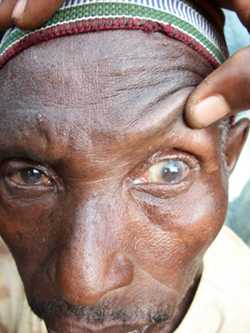The Burden of Trachoma

Man blinded by trachoma. CDC photo, Sonia Pelletreau
Trachoma is an infectious disease of the eye cause by a bacteria called Chlamydia trachomatis. Five hundred forty million people are at risk in 55 countries, and 84 million are already infected. Repeated infections cause the eyelids to turn inward, at which point the eyelashes scrape and permanently scar the cornea. This stage of trachoma infection is called trichiasis and can lead to blindness.
The disease spreads quickly through close personal contact and often is more common in areas where people live close together. Often, whole communities can be affected. For these reasons, trachoma infections are often common in the poorest communities.
Trachoma is particularly common in children who are less than five years of age and in the adults – mainly women – who care for them. In some rural communities, 60 – 90 percent of children are infected.
More on: Trachoma
References
- Burton MJ, Mabey DCW. The Global Burden of Trachoma: A Review. PLoS Negl Trop Dis 2009 3(10): e460.
- Page last reviewed: June 6, 2011
- Page last updated: June 6, 2011
- Content source:


 ShareCompartir
ShareCompartir